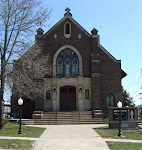This article was recommended by Fr. Pisut.
Noble Simplicity as Expressed Through Cistercianesque Sobriety: One Variant (Updated)
Now all this said, there is a place within our tradition for what we might call a more sober approach -- historically we might see this expressed within the Cistercian architectural tradition for example. While this is not the only approach to noble simplicity and noble beauty -- let me be clear -- it is certainly one approach, and one which some today wish to explore -- or one which they at least feel compelled to explore for one or another practical reasons.
As such, it seems worthwhile to explore how this particular approach might be manifest well and in continuity with our tradition, particularly since so many modern attempts at it have tended toward a cold, sterile, and impoverished minimalism rather than a more sober form of beauty.
In considering what might serve as a reasonably modern example of how this particular approach might be expressed, my mind immediately turned to a particular chapel which could be understood as a modern heir to that certain kind of historical Cistercian simplicity we have mentioned. It is the chapel of St. Stephen's House built for the Anglican Cowley Fathers (that is, the Society of St. John the Evangelist) which includes a ciborium magnum which was designed by Sir Ninian Comper:
 |
| (Photo by Br. Lawrence Lew) Now in showing this particular example (which gives a good sense of the chapel in daylight), I would note that the altar shown above (which is admirable and noble in its own right, but out of proportion with the ciborium) is not the original which was wider and solid in form and thus more substantial; nor is this the altar that presently sits within this chapel, which is now closer again to the original. The original altar, as in the case of the present arrangement seen below, was also vested with antependia, which provided a striking bit of liturgical colour; it further had a carpet which led up to the altar. All of this lent and lends primacy and centrality to the altar, providing added colour and warmth to the whole arrangement, while still retaining its sobriety and simplicity. Consider the present arrangement which is more proximate to the original and intended view of the chapel when it was constructed. For the rest of the article click here: The New Liturgical Movement |





